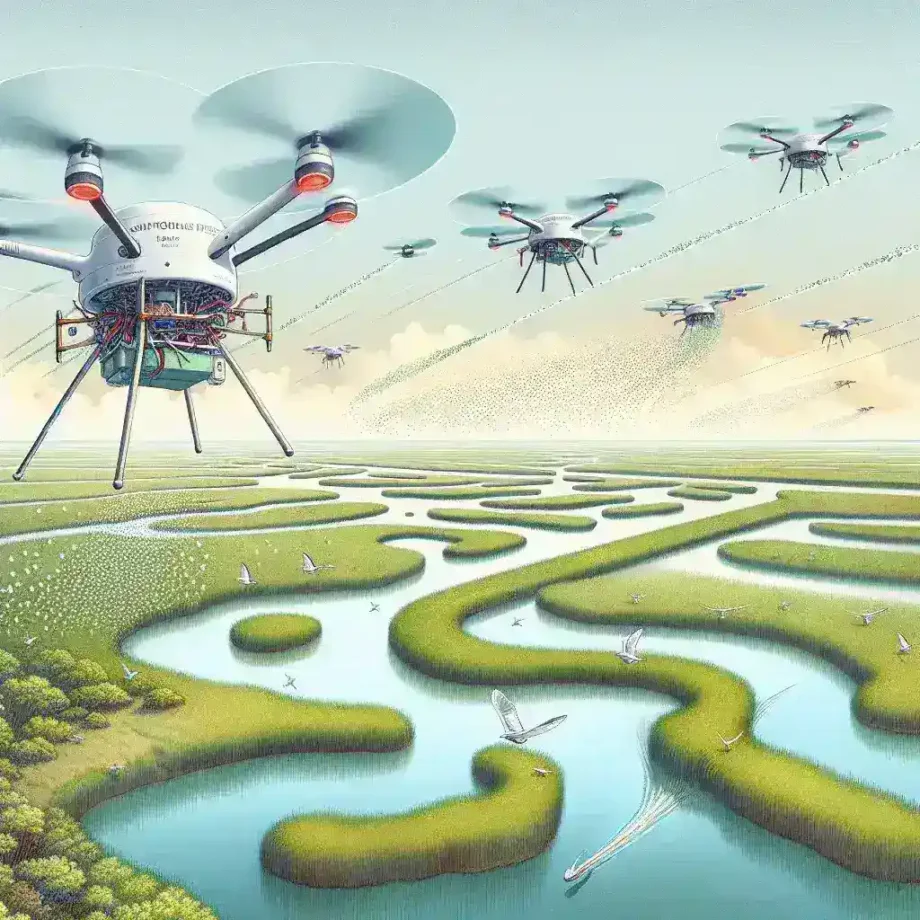
Introduction
Wetlands are vital ecosystems that provide numerous environmental benefits, including water filtration, flood control, and habitat for diverse species. However, urbanization, agriculture, and climate change have significantly degraded these crucial areas. To combat this, innovative technologies are emerging, one of which is the use of AI-guided drones equipped with precision seeding technology. This article explores how these drones are changing the landscape of wetland restoration.
The Historical Context of Wetland Degradation
Wetlands have faced severe threats over the past century. Historically, they were viewed as wastelands, leading to extensive drainage and conversion to agricultural land. Approximately 50% of the world’s wetlands have been lost since the 1900s, a trend that continues to raise alarms among environmentalists and scientists. The consequences of this degradation extend beyond the loss of biodiversity; they affect climate regulation and water quality.
Understanding AI-guided Drones
What Are AI-guided Drones?
AI-guided drones are unmanned aerial vehicles (UAVs) that use artificial intelligence to navigate and perform specific tasks. These drones can analyze their environment, make decisions, and execute pre-programmed missions without human intervention. In the context of wetland restoration, they are equipped with precision seeding technology to optimize the planting of native vegetation.
How Precision Seeding Works
Precision seeding technology involves the use of advanced algorithms and sensors to determine the most effective locations for seed deployment. Drones can assess soil conditions, moisture levels, and existing vegetation, ensuring seeds are planted in areas where they are most likely to thrive.
The Process of Wetland Restoration Using Drones
Step 1: Assessment and Planning
The first step in any restoration project is to assess the area needing restoration. Drones equipped with multispectral cameras can gather data on vegetation health, soil types, and topography. This data is analyzed using AI software to create a detailed restoration plan.
Step 2: Seed Selection
Choosing the right seeds is crucial for successful wetland restoration. Native plant species are selected based on their adaptability to local conditions. This selection process ensures that the new plants can establish themselves and support the local ecosystem.
Step 3: Drone Seeding Mission
Once the assessment is complete and seeds are selected, the drones are programmed for the seeding mission. The drones fly over the designated area, using GPS and AI to drop seeds at optimal locations. This method not only increases efficiency but also reduces the disturbance of existing soil and vegetation.
Step 4: Monitoring and Maintenance
After seeding, the drones can continue to play a role in monitoring the newly restored wetland. Equipped with sensors, they can provide ongoing data about plant growth, soil moisture, and potential threats like invasive species. This information allows for timely interventions and maintenance, ensuring the restoration efforts succeed.
The Benefits of Using Drones in Wetland Restoration
1. Efficiency and Speed
Traditionally, wetland restoration is a labor-intensive process that can take years to complete. Drones significantly speed up the seeding process, allowing for larger areas to be restored in a fraction of the time.
2. Precision and Accuracy
The precision of drone technology minimizes waste and maximizes the chances of successful seed germination. This targeted approach ensures that resources are used effectively.
3. Reduced Environmental Impact
Drones can access areas that are difficult for humans to reach without causing soil disturbance. By minimizing the physical impact on the land, drones help preserve the integrity of the ecosystem.
4. Cost-effectiveness
While the initial investment in drone technology may be high, the long-term savings in labor and resources can make drone-assisted restoration projects more cost-effective.
Challenges and Considerations
1. Technological Limitations
While the technology is advancing, there are still limitations in drone flight times and payload capacities. These factors can impact the scale of restoration efforts.
2. Regulatory Challenges
The use of drones is subject to aviation regulations that can vary by country. Navigating these regulations can be a hurdle for organizations looking to employ drone technology.
3. Public Perception
There can be skepticism regarding the effectiveness of using drones for ecological restoration. Educating the public about the benefits and successes of drone-assisted projects is crucial for wider acceptance.
Real-World Applications and Case Studies
Case Study 1: The Great Lakes Restoration Initiative
The Great Lakes Restoration Initiative has employed drones in various projects aimed at restoring wetlands around the Great Lakes. By using drones, they have been able to effectively monitor and seed areas that were previously inaccessible.
Case Study 2: California’s Delta Restoration
In California, drones are being used to restore the Sacramento-San Joaquin Delta. The project focuses on restoring native plant species and improving water filtration, showcasing the potential of AI-guided drones in large-scale environmental restoration.
Future Predictions for Drone Technology in Restoration
The future of using AI-guided drones in wetland restoration looks promising. As technology continues to advance, we can expect improvements in drone capabilities, increased regulatory support, and broader acceptance among environmental organizations. These advancements could lead to a more widespread implementation of drone technology, making it a standard practice in ecological restoration efforts.
Conclusion
AI-guided drones represent a significant advancement in the field of wetland restoration, combining technology with ecological preservation. Their ability to restore wetlands with precision seeding technology not only enhances biodiversity but also promotes sustainability in our ecosystems. As we face the challenges of climate change and habitat loss, embracing innovative solutions like drone technology will be essential for the future of our planet.
